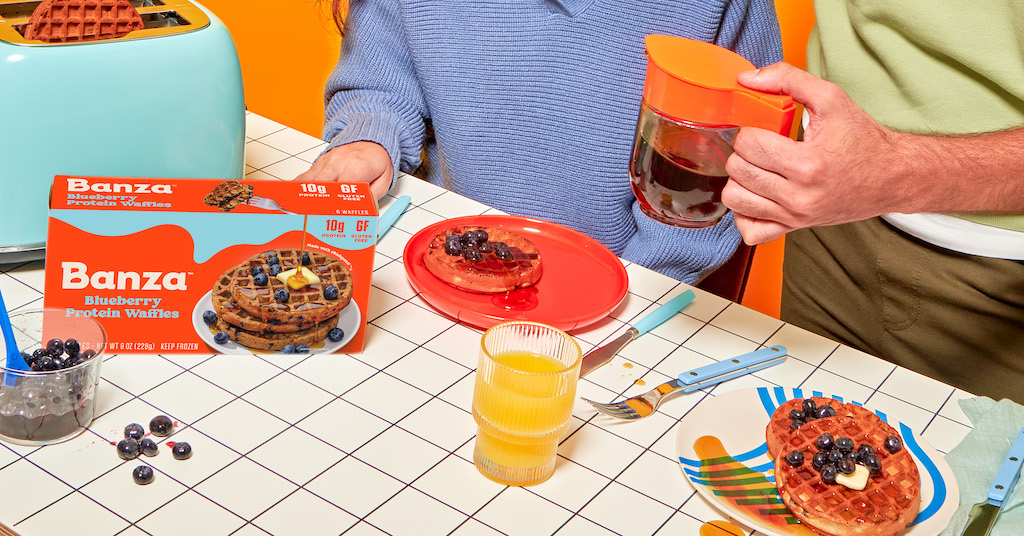How Banza is expanding its product portfolio of better-for-you comfort foods

Earlier this month, chickpea pasta maker Banza announced its first foray into breakfast foods with a line of frozen waffles.
Banza first launched in 2014, debuting with chickpea pasta as a gluten free, protein-rich alternative to standard dry pastas. That was followed by the launch of other chickpea-based products, like mac and cheese in 2016 and rice in 2019. The waffle release is the fifth product line for the company, and expands Banza’s presence in the freezer section following the launch of the company’s frozen pizzas in 2020. As one of the earlier examples of startups aiming to disrupt grocery categories with better-for-you products, Banza is now looking to own more of the frozen aisle. With Banza about to reach a decade of operation, the company wants to continue building its product lines to go beyond dinnertime.
Banza is now available in 25,000 retail locations around the U.S. — compared to 12,000 in 2019 — including Walmart, Target, Whole Foods and Costco, among others. This year, national distribution is up by 20% year-over-year. In the past four years, Banza has grown nearly 3X, with the company saying it now serves nine million people. Banza has raised about $30 million in venture capital, with its $20 million Series B round closing in 2019.
Banza co-founder Brian Rudolph told Modern Retail that when Banza launched, the company had to introduce buyers and customers to the novelty of chickpea-based pasta. “Now, we’re the number five pasta in the country, and the only companies ahead of us are traditional pastas,” he explained. Today, alternative pastas made from beans and legumes can be found on most grocery shelves – with even major pasta makers creating their own versions to keep up with dietary trends.
Rudolph said when launching a new product, the company taps a group of fans, including influencers, to sample the product for free and with no stipulation to promote it. “Many times that helps build buzz for the release,” Rudolph said. This strategy was borne out of the company’s early days of betting on free taste tests, in which Banza sent personalized messages to online journalists and influencers asking them to try the pasta for free. Over time, the brand gained a celebrity following, from Lizzo to Kristen Bell, who share their Banza recipes with millions of followers.
“There are no questions asked,” Rudolph said of the gifting strategy, and, in the past, it has resulted in some negative reviews. However, the company continues to rely on online word-of-mouth to create excitement around its products.
Since venturing beyond the pantry, Banza has been trying to gain insights into how frozen food shoppers make purchases. For instance, these customers are typically looking for quick and convenient ways to eat more nutritious versions of their favorite foods. “Breakfast came up as a pain point for a lot of people, and they don’t have a consistent option they eat everyday,” Rudolph said. “We thought through the ways we can create something that’s quick, nutritious and delicious,” he said of the nostalgic breakfast dish.
The company rolled out the waffles exclusively at Whole Foods as it generates awareness around the product, through digital and in-person marketing activations. Rudolph said the company recently adopted this tactic as a way to test and learn before putting the product in every retailer.
“We’re super intentional about how we roll out the products, and the goal is to learn what’s working and not working,” he added.“It’s like a safer sandbox.” In this sense, Rudolph said, the company tries to only expand certain products to retailers where they’re most likely to succeed. This is becoming especially true, he explained, now that grocery chains are looking to “check the box” by filling their shelves with better-for-you products.
In-store demos are also a big part of Banza’s product launches. “In the early days we did farmers markets,” Rudolph said. “There is really no better way to build awareness and trial, especially for novel products like ours where people want to know if it tastes good.”
But being on a shelf, Rudolph said, has been one of the biggest growth drivers for Banza. “That’s why we put so much thought into our packaging design,” he said of Banza’s eye-catching orange boxes, which the company began using in 2016.
Brand and communications strategy consultant Carly Sutherland said Banza’s growth is part of the ongoing trend of people looking for healthier, nutrient-dense versions of their favorite recipes.
“I think Banza’s expansion is not just about catering to more meals in the day but to also solve for true, long standing consumer pain points when it comes to their favorite but guilt-ridden foods,” Sutherland explained. She added that, just as it did for pasta, Banza is capitalizing on the growing popularity of low-carb, high-protein breakfast waffles, following the success of keto-friendly pancake mixes. “We’re seeing this for bagels as well,” Sutherland said. “Making ‘bad’ food better-for-you and taste good is becoming a consumer expectation and brands that can accomplish both will win.”
The next step for Banza will be to add more flavors of waffles to grow out the line, Rudolph said, as well as expand pasta. “Over time, we want to make every pasta shape and variation that’s available in regular pasta,” Rudolph said. “That’s going to take a good amount of shelf space.”
“We want people to eat more beans, and if other brands are introducing products to build this out then that’s great,” Rudolph said. “It was inevitable and validates that what we’re doing is working.”

